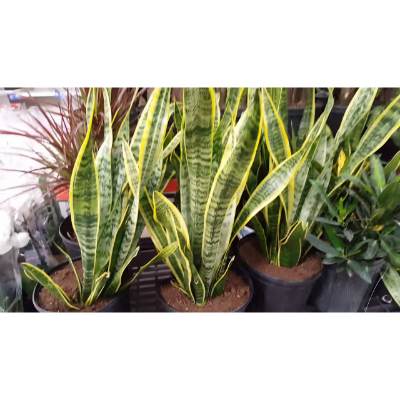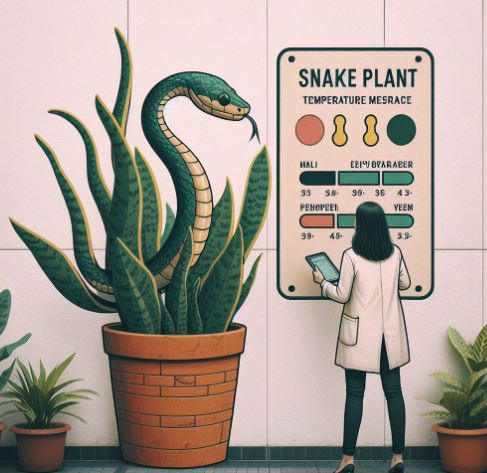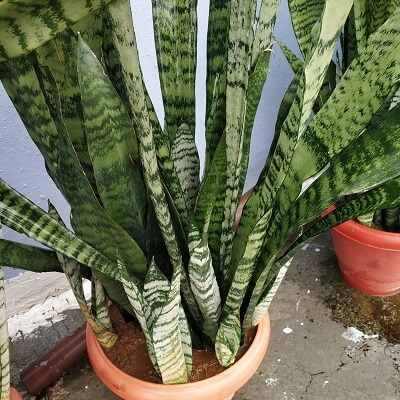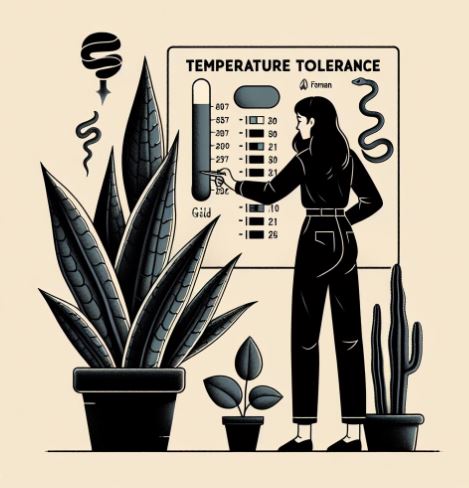Snake plants, also known as Sansevieria, have captured the hearts of plant enthusiasts with their unique appearance and remarkable resilience. One key aspect of their care is understanding their temperature preferences to ensure they thrive in various environments.
Snake Plant Basics
Snake plants, originating from Africa, have evolved to endure challenging conditions, making them an excellent choice for both novice and experienced plant owners. Understanding the basics of these resilient plants is crucial for providing optimal care.
Snake plants exhibit a remarkable temperature tolerance, with an optimal range between 70°F and 90°F (According to New york Botanical Gardens). This temperature sweet spot promotes vigorous growth and overall well-being. However, these plants can withstand lower temperatures down to 50°F, but caution is necessary to prevent cold damage.
When cultivating snake plants, it’s essential to mimic their native habitat. In Africa, these plants have adapted to survive in temperatures ranging from scorching heat to milder conditions. While snake plants can tolerate short periods of low temperatures, they are not frost-resistant. Extended exposure to temperatures below 50°F can be detrimental and even fatal.
Temperature Ranges for Snake Plants

For those accustomed to Celsius measurements, the optimal temperature range for snake plants translates to approximately 21°C to 32°C. Understanding these metrics aids in creating a comfortable environment for these tropical wonders.
Snake plant owners must pay close attention to indoor temperature management. Maintaining an indoor climate within the recommended range ensures the plants remain healthy and vibrant. It’s advisable to keep indoor temperatures between 18°C and 27°C, adjusting as needed based on seasonal changes.
To safeguard snake plants from the adverse effects of cold temperatures, consider relocating them to a warmer spot during winter. Indoor adjustments, such as avoiding drafts and maintaining consistent temperatures, contribute to the overall well-being of these adaptable plants.
Snake Plant Temperature Tolerance Indoors
Bringing snake plants indoors requires thoughtful consideration of the temperature aspects. Indoor environments can vary, and ensuring an ideal climate is vital for the plants’ longevity.
Indoor temperatures should ideally hover around 21°C to 24°C during the day and can dip slightly at night. Snake plants can tolerate variations, but drastic fluctuations should be avoided. Employing temperature control devices, such as thermostats, helps create a stable and comfortable habitat.
Avoid placing snake plants near sources of extreme heat or cold, such as radiators or air conditioning units. These can disrupt the plant’s natural temperature balance, leading to stress and potential damage. Additionally, monitor the temperature around windows during winter, as cold drafts can affect the well-being of indoor snake plants.
check out the below a funny image we created.

Effects of Cold Damage onSnake Plants
Understanding the symptoms and repercussions of cold damage is crucial for proactive care. When subjected to low temperatures, snake plants may exhibit signs of distress that demand immediate attention.
Common symptoms of cold damage include wilting, discoloration, and mushy leaves. If these signs manifest, it’s essential to act promptly. Begin by relocating the affected plant to a warmer area, away from cold drafts. Trim damaged leaves using sterile pruning shears to encourage new growth.
Recovery from cold damage is possible with diligent care. Providing a stable and warmer environment, adjusting watering practices, and applying a balanced fertilizer contribute to the plant’s rehabilitation. Patience is key, as snake plants can gradually bounce back with proper attention.
Spider Plant Temperature Tolerance Comparison With Snake Plant

Spider plants, like snake plants, are favored choices for indoor greenery. Comparing their temperature preferences provides valuable insights for plant enthusiasts seeking the ideal match for their specific environments.
Contrasting Snake Plant and Spider Plant Tolerance
While both snake plants and spider plants share some tolerance to diverse conditions, there are notable differences. Spider plants generally prefer slightly cooler temperatures compared to snake plants. Understanding these distinctions aids in making informed decisions when selecting the right plant for a particular setting.
Similarities in Temperature Preferences
Despite their differences, snake plants and spider plants share a commonality in their ability to thrive in indoor conditions. Both plants can adapt to a wide range of temperatures, making them versatile choices for various climates.
Choosing between snake plants and spider plants ultimately depends on personal preferences and the specific conditions of the intended environment. In the subsequent section, we explore the crucial role of light in snake plant care.
FAQs on Snake Plant Temperature Tolerance
What is the lowest temperature for a snake plant outside?
Snake plants can tolerate temperatures down to 50°F (10°C) for short periods. However, extended exposure to temperatures below this threshold can lead to severe damage or even death.
At what temperature should I bring my snake plant inside?
It’s advisable to bring your snake plant inside when temperatures drop below 50°F (10°C). Prolonged exposure to colder temperatures can harm the plant, so relocating it indoors during colder months is a protective measure.
Can snake plant go outside in summer?
Yes, snake plants can thrive outdoors in the summer. They can withstand warmer temperatures, but it’s crucial to avoid placing them in direct, intense sunlight for extended periods to prevent sunburn.
Can snake plants take full sun?
While snake plants can tolerate some direct sunlight, prolonged exposure to full sun can lead to leaf damage, including sunburn. It’s best to provide them with filtered or indirect sunlight to maintain their health.
Can I put my snake plant outside?
Yes, you can put your snake plant outside, especially during the warmer months. However, be mindful of temperature extremes and sunlight exposure, and consider gradual acclimatization to prevent stress.
When can I take my snake plant outside?
You can take your snake plant outside when the risk of frost has passed and temperatures consistently stay above 50°F (10°C). This is typically during the warmer months of spring and summer.
Can a snake plant survive in the cold?
While snake plants can tolerate short periods of cold, they are not frost-resistant. Extended exposure to cold temperatures, especially below 50°F (10°C), can result in severe damage or death. Protective measures are essential in colder climates.
Can Snake Plants Survive in Cold Climates?
Snake plants can tolerate short periods of cold weather, but they are not suited for frosty climates. Extended exposure to temperatures below 50°F (10°C) can lead to severe damage or even death. Consider protective measures such as moving potted snake plants indoors during winter to safeguard them.
What Should I Do if My Snake Plant Shows Signs of Cold Damage?
If your snake plant exhibits symptoms of cold damage, act promptly to prevent further harm. Move the affected plant to a warmer location, trim damaged leaves using sterile tools, and provide extra care, including adjusting watering practices and applying a balanced fertilizer.
Is it Possible to Overheat a Snake Plant?
While snake plants are hardy, extreme heat can still be detrimental. Avoid placing them near heat sources or in direct sunlight for prolonged periods, especially during scorching summer months. Adequate shade and proper ventilation can prevent overheating and stress.
How Do I Protect Snake Plants During Winter?
Winter poses challenges for snake plants, especially in colder regions. Consider bringing potted snake plants indoors or providing additional insulation for outdoor plants. Monitoring indoor temperatures and protecting plants from cold drafts are essential measures.
What Temperature Range is Considered Too Hot for Snake Plants?
Snake plants thrive in temperatures between 70°F and 90°F (21°C – 32°C). While they can tolerate higher temperatures for short periods, extended exposure to temperatures above this range can lead to stress and potential damage. Adequate shade and proper ventilation help mitigate heat-related issues.
In the subsequent section, we explore the integration of snake plants into indoor climate management, emphasizing their role in creating a conducive atmosphere.
Snake Plant Temperature Tolerance Case Studies

Examining real-life scenarios provides valuable insights into the adaptability of snake plants to various temperature challenges. These case studies offer practical examples of successful plant management in different settings.
Real-life Examples of Temperature Challenges
- Hot and Dry Environments: In regions with prolonged hot and dry weather, snake plants have thrived when placed in shaded areas. Providing occasional misting helps maintain adequate humidity levels, ensuring the plants remain vibrant.
- Cold Climates with Proper Protection: Instances of snake plants thriving in cold climates involve strategic protection measures, such as using frost covers or relocating potted plants indoors during winter. These measures shield the plants from extreme cold, promoting their well-being.
Successful Snake Plant Adaption to Varied Environments
- Indoor Office Spaces: Snake plants have become popular choices for office environments with limited natural light. Their ability to tolerate low light and infrequent watering makes them ideal for busy office settings, contributing to a green and vibrant workspace.
- Outdoor Gardens with Temperature Fluctuations: Snake plants planted in outdoor gardens have showcased resilience to temperature fluctuations. Mulching around the base helps regulate soil temperature, while proper watering practices ensure their adaptability to changing environmental conditions.
Learning from Other Plant Enthusiasts’ Experiences
Engaging with the experiences of fellow plant enthusiasts provides a wealth of knowledge. Online forums, social media groups, and community events offer platforms for sharing insights and seeking advice on optimizing snake plant care based on temperature considerations.
In the concluding section, we summarize the key points covered in this comprehensive guide to snake plant temperature tolerance.
Snake Plant and Indoor Climate
Snake plants contribute not only to aesthetics but also to indoor climate regulation. Understanding how to leverage these plants for optimal indoor conditions enhances their functionality beyond ornamental purposes.
Creating an Ideal Indoor Climate
Snake plants excel at improving indoor air quality, making them valuable additions to homes and offices. Strategically placing multiple snake plants in different rooms enhances their air-purifying effects, contributing to a healthier living environment.
Using Temperature Control Devices
Incorporating temperature control devices, such as thermostats and humidifiers, enhances the effectiveness of snake plants in indoor climate management. These devices provide precise control over temperature and humidity levels, creating a comfortable habitat for both plants and occupants.
Incorporating Snake Plants into Indoor Design for Temperature Regulation
Beyond their functional benefits, snake plants add a touch of greenery to indoor spaces. Integrating them into interior design not only enhances visual appeal but also contributes to temperature regulation. Large snake plants positioned strategically can act as natural climate modifiers.
In the subsequent section, we explore real-life case studies showcasing snake plant temperature tolerance in diverse environments.
Snake Plant Temperature Tolerance: Conclusion
In conclusion, mastering the art of caring for snake plants involves a nuanced understanding of their temperature preferences. From optimal temperature ranges to adapting to indoor climates, snake plants demonstrate remarkable resilience when provided with thoughtful care.
Ensuring a comfortable temperature range, protecting against cold damage, and leveraging the benefits of snake plants in indoor climate management contribute to their overall well-being. The interplay of light, water, and temperature creates a harmonious environment for these adaptable plants to thrive.
As you embark on your journey with snake plants, remember that each plant may respond uniquely to its environment. Observing and adjusting care practices based on individual needs fosters a rewarding and enduring relationship with these captivating green companions.
Benefits of Snake Plants
Beyond their temperature resilience, snake plants offer a plethora of benefits that make them a favorite among plant enthusiasts. These benefits extend from air purification to low maintenance requirements, creating a compelling case for incorporating snake plants into indoor spaces.
- Air Purification Properties: Snake plants are renowned for their ability to purify indoor air by removing toxins such as formaldehyde and benzene. This natural air filtration contributes to a healthier and more enjoyable living environment.
- Low Maintenance and Hardiness: The hardiness of snake plants makes them an excellent choice for individuals with busy lifestyles or those new to plant care. Their ability to withstand varying temperatures, low light conditions, and infrequent watering makes them nearly indestructible.
- Aesthetic Appeal in Indoor Spaces: Snake plants boast an elegant and architectural appearance, adding a touch of sophistication to indoor spaces. Their upright leaves and variegated patterns make them not only resilient but also visually pleasing.
Light Requirements for Snake Plants
Proper exposure to light is paramount for the health and vibrancy of snake plants. Understanding their light requirements and adapting care practices accordingly ensures these plants flourish in their indoor habitats.
Importance of Adequate Light
Snake plants are classified as low to moderate light plants, meaning they can tolerate lower light conditions but thrive in moderate light. Placing them in areas with indirect sunlight or filtered light contributes to optimal growth.
Tolerance to Low Light Conditions
One of the remarkable features of snake plants is their ability to survive in low light conditions. This adaptability makes them suitable for spaces with limited natural light, such as offices or rooms with smaller windows.
Best Practices for Sunlight Exposure
While snake plants tolerate low light, it’s essential to strike a balance. Exposing them to too much direct sunlight can lead to sunburn, manifesting as brown spots on the leaves. To prevent this, position snake plants where they receive filtered or indirect sunlight.
In the subsequent section, we shift our focus to another crucial aspect of snake plant care—watering guidelines.
Snake Plant Care: Watering Guidelines
Proper watering is fundamental to the well-being of snake plants. Understanding the watering needs and signs of overwatering or underwatering ensures these resilient plants receive the care they deserve.
Watering Frequency and Amount
Snake plants have a moderate watering requirement, and overwatering is a common mistake among plant owners. Water them when the top inch of the soil feels dry to the touch, usually every two to three weeks. Ensure the water drains well, preventing waterlogged soil.
Signs of Overwatering and Underwatering
Overwatering can lead to root rot, which manifests as yellowing and mushy leaves. On the other hand, underwatering results in dry and crispy leaves. Monitoring the plant’s appearance and adjusting watering frequency accordingly is essential for maintaining its health.
Adjusting Watering Practices Based on Temperature
Temperature fluctuations influence the water needs of snake plants. During warmer months, they may require more frequent watering, while reduced watering in colder months aligns with their dormant period. Adapting to these seasonal variations contributes to a balanced care routine.
Moving forward, we explore the relationship between snake plants and sunlight, shedding light on the delicate balance required for optimal growth.
Snake Plant Sunlight: Finding the Right Balance
Sunlight plays a pivotal role in the photosynthesis and overall well-being of snake plants. Striking the right balance between exposure and protection ensures these plants thrive without succumbing to sunlight-related issues.
Understanding Sunlight Needs
Snake plants are adaptable and can tolerate a range of light conditions, but they prefer indirect sunlight. Placing them near windows with sheer curtains or in areas with filtered light replicates their natural habitat and supports healthy growth.
Avoiding Direct Sunlight Damage
While snake plants tolerate sunlight, exposure to direct, intense sunlight can lead to leaf damage. Sunburn manifests as brown, crispy spots on the leaves. Shielding them from prolonged direct sunlight prevents such issues, preserving the plant’s aesthetics.
Adapting to Seasonal Sunlight Changes
Seasonal changes impact sunlight exposure, and snake plants respond accordingly. During winter, when sunlight is less intense, consider moving them to well-lit areas. Conversely, in summer, providing some shade protects them from the harsh midday sun.
In the subsequent section, we delve into frequently asked questions (FAQs) related to snake plant temperature tolerance, addressing common concerns and offering practical solutions.
